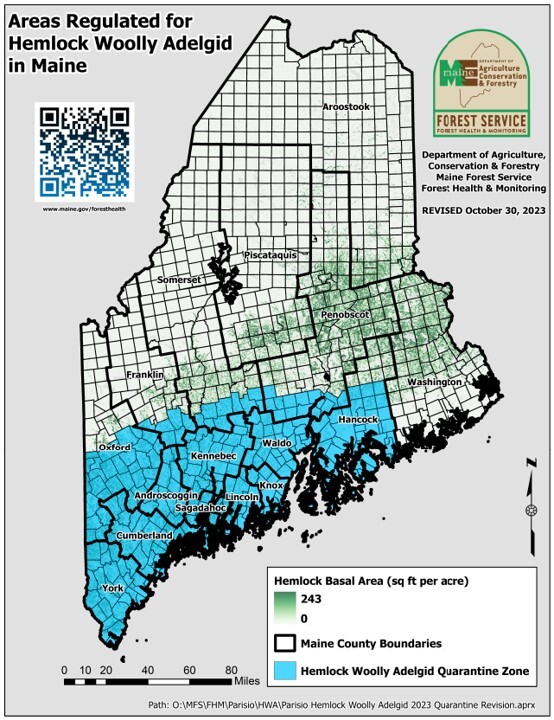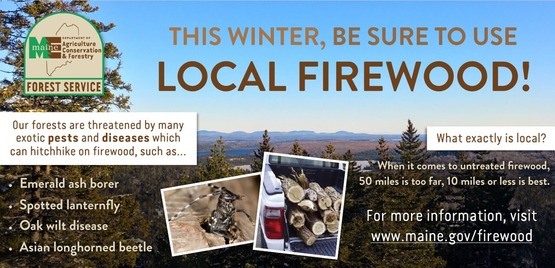Maine DACF Forestry Related Quarantine Rules Updated
Maine DACF has recently updated rules that govern the movement of two introduced insects and a fungal disease, as well as the products that can carry each of them to new places. Quarantines can help slow the spread of introduced species. If you plan on moving ash, hemlock or larch trees or raw material from these species, such as logs, chips or firewood, become familiar with these rules. You can help slow the spread of these destructive organisms and limit their impacts on Maine’s forests and forest industry.
The changes to the emerald ash borer (EAB) quarantine, Chapter 275, are designed to protect Maine's forest and timber resources to slow the movement of the EAB to uninfested parts of the State. The rule slightly enlarges the quarantined area in Northern Aroostook County and adds all or parts of multiple new counties in southern Maine. In response to input during public listening sessions, it is smaller than the previous emergency order area. These measures help protect over 60 percent of the ash resource that is still outside the current quarantine areas of Maine. EAB is also federally regulated in adjacent Canada.
Regulated articles include emerald ash borer in any life stage, hardwood firewood, ash (Fraxinus spp.) material including rooted plants, green lumber with any bark, live edge or wane and other material living, dead, cut or fallen including logs, stumps, roots and branches.
More EAB Resources:
The changes to the hemlock woolly adelgid (HWA) quarantine, Chapter 266, modify the existing HWA quarantine by extending it to additional counties and Minor Civil Divisions in southern Maine. This expansion is needed because HWA populations were discovered outside the previous quarantine area. HWA is also regulated in a limited number of other states and in Canada.
Regulated articles include material, such as chips, with branches and rooted plants.
 More HWA resources:
The adjustments to the European larch canker quarantine, Chapter 272, expand a state quarantine against the European larch canker to prevent its movement from Hancock, Knox, Lincoln, Sagadahoc, and Waldo Counties and parts of Androscoggin, Cumberland, Penobscot, and Washington counties to other parts of the State to protect Maine's forest and landscape tree resources. The European larch canker is federally regulated, and this rule fulfills the requirement that Maine must have a similar state quarantine in place because the state is partially regulated for European larch canker. European larch canker is also federally regulated in adjacent Canada.
Regulated articles include logs, pulpwood, branches, twigs, plants, scion and other propagative material of the Larix or Pseudolarix spp. except seeds.
More European larch canker resources:
The organisms targeted by these rules are not everywhere within the regulated areas. Consider limiting the movement of the affected tree species or conducting processing that reduces the spread risk even within the quarantine areas. Often, harvesting during the late fall or winter and then processing, such as heat treating, burning, or burying, before spring is an effective approach. Be aware that any movement of regulated items from within a quarantine area to areas outside the quarantine is strictly prohibited without a valid agreement with the Maine Forest Service.
Firewood is regulated by many quarantine rules, including emerald ash borer and spongy moth. It is also known to carry pests that are not regulated, such as browntail moth, spotted lanternfly, and exotic ambrosia beetles, among others. For this reason, use local firewood. It is illegal to import untreated firewood into Maine from other states, and using local firewood within Maine is best.

Firewood is subject to various quarantine rules, addressing concerns like the Asian longhorned beetle, emerald ash borer and spongy moth. Additionally, it can harbor unregulated pests like the browntail moth, spotted lanternfly, and exotic ambrosia beetles. To mitigate these risks, use local firewood!
- Remember, importing untreated firewood from other states into Maine is illegal.
- Using locally sourced firewood within Maine is recommended. It ensures compliance with regulations and helps slow the spread of exotic forest pests.
- As a general rule of thumb, 50 miles is too far for local firewood, and 10 or less is best.
You can find more firewood tips on our website.
Want to get our newsletters? Enter your email address in the box on the right side of our sign up page.
|